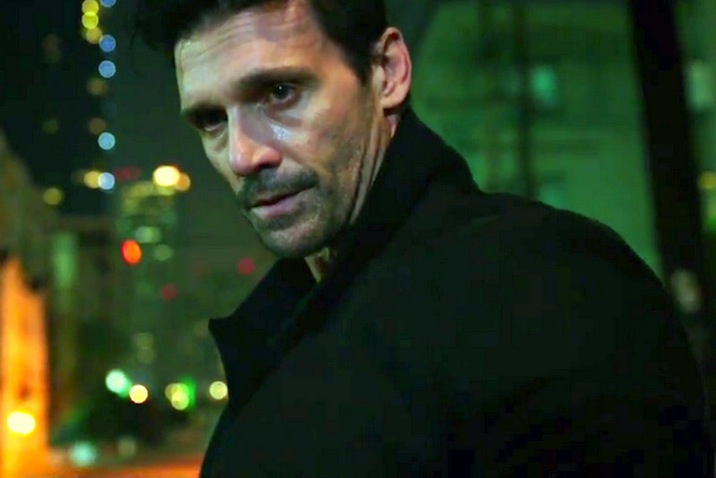 It doesn’t take a thinking person more
It doesn’t take a thinking person more
than ten seconds to poke holes in the premise of “The Purge." It
also doesn’t take one to see the seductive hook of the material:
Americans acting upon some sort of birthright to behave like animals,
to let loose the chains of propriety and savagely end each other.
“The Purge: Anarchy” takes place in 2023, and the surprise isn’t
that the American dream has become, “Fend for yourself, leave
others behind.” No, the surprise is in why this sentiment
necessitates the film taking place nine years in the future.

“The Purge: Anarchy” borrows
nothing from the earlier film in the franchise other than the
premise: Every year on March 21st, a twelve hour period
allows Americans the freedom to commit crime of any sort, which for
many includes murder and assault. Some find themselves willing to
“purge” to allow their demons to rest during the rest of the
year. Others seek revenge, The Purge representing a chance to provide
equality to the scale of “good and evil.” And, as the first film
suggested, the government sees it as a chance to wipe away the lower
class and minorities, so that they may boast of lower unemployment
and homeless statistics.
That last angle is pushed harder in ‘Anarchy,’ which switches gears from the 1%-leaning first film to
showcase people on their last legs financially. Carmen Ejogo and Zoe
Soul are a mother-daughter combo just barely getting by in the
projects, struggling to afford Dad’s medication. And Zach Gilford and
Kiele Sanchez are a couple on the verge of breaking up, though the
fact that she drives and pays for groceries as he stews suggests
finances might be a point of contention as well. Both of these duos
elaborate on their economic problems in repetitive dialogue that
suggests subtext has been left behind. Then again, many of the film’s
political points are made early on by Michael K. Williams as a
truth-to-power rebel on the internet who sees that the Purge is very
obviously financially-driven. The movie never questions his prophet
status because iconography and fake-activism are more important to
the movie than actually developing sharp critique. Better to have
mouthpieces than actual mouths.

And then there’s Frank Grillo, armed to
the teeth, walking into this film like a star ten times his size.
Grillo, a hard man in a soft cinematic world, cuts an intimidating
figure. In a long trenchcoat and five o’clock shadow, he does what
all great movie stars do: he lets the other characters know he’s one
of them, but otherwise seems a hundred feet tall. Other actors are
merely leasing the screen. Grillo, with his ornery, rock-edged
handsomeness and action-ready physique, owns it. His Leo Barnes
stands at a stark contrast to the film’s bumbling, often incompetent
action, as if he were on loan from another, better franchise. It’s
not too late to re-title the film “Frank Grillo Vs. The Purge”.
Grillo brings a grounded reality to the
movie, one that otherwise doesn’t seem apparent. ‘Anarchy’ takes
place in a nondescript Los Angeles so small that Barnes and the rest
of this crew (all dim and relatively useless) keep bumping into the
same motorcycle gang and evil delivery truck all night. The movie
takes on the feel of a first-person shooter video game, though the
movie is even less expansive than one of those diversions, and each
block feels just as dangerous, and eventually samey, as the last.
Barnes knows how to handle a gun (and otherwise-unskilled director
James DeMonaco knows how to make him look good), which gives the film
sort of a visceral thrill. The violence of the first film was
punishing and unpleasant, and ultimately meant to guilt the
bloodthirsty audience that paid money to see it. This one veers
further from actual horror into an action picture. “The Purge”
tries to unsettle. “The Purge: Anarchy” wants you to cheer.

Because the film showcases lower income
characters, of course it’s going to veer into rich-eat-the-poor
territory. The disappointment is that is shows its hand so early, and
so sloppily, that the rest of the film is compromised by crushing
inevitability. “The Purge: Anarchy” depicts class warfare as a
way of life, but it also delights in creating wealthy villains who
have no need to hide behind the masks of propriety and societal
expectations. On paper, this approach seems scarier, the idea that
those that who approve of the power of the government and the
subjugation of minorities and the lower class are secretly insidious
killers, sociopaths who fist-bump after a slaying. But the
characterizations are completely divorced from reality, all
cartoonish old hens and white-haired devils with plastic smiles and
banal evil schemes. Why would evil need to hide in the world of “The
Purge” when political evil doesn’t even hide today? Why does the
world of “The Purge” need a talking head like Michael K. Williams
to tell them what anyone should be able to figure out about the roots
of The Purge?
Ultimately, these movies are hopeless.
There’s no heroism in the world of “The Purge”, just opportunism.
These films benefit from the notion that, if given complete freedom,
humanity will embrace their worst urges, they’ll cave and submit to
their most primal desires. One principled character experiences great
loss in the third act and solemnly declares, out of nowhere, “I
want to Purge.” This is false catharsis, the sort of violence-first
attitude that obscures and beats down any socioeconomic point the
movie wants to make. Capitalism poisons the well, the film argues.
But a couple of guns and some hurt feelings suggest that freedom is
just a couple of bullets away. We currently live in a country where
some towns actually require households to own guns. Maybe if “The
Purge: Anarchy” had as much of a sense of humor as reality, it
would have something to say. [D+]

